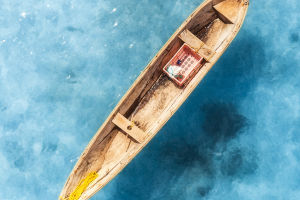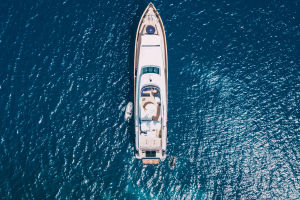The calm and tranquil ocean is the longing of every sailor, but bad weather brought by typhoons or winter seas often accompanies solid winds and huge waves.
Generally, severe weather at sea refers to wind forces of level 7 and above and waves higher than 5 meters.
On the open ocean, the wavelength is typically between 80-140 meters, corresponding to wave periods of 7-10 seconds. Ships navigating along the coast or near the ocean mainly focus on avoiding rough seas due to their smaller tonnage, while boats on transoceanic voyages often have nowhere to hide and must prepare in advance and take appropriate measures.
When sailing in strong winds and high waves, ships should adopt the following navigation procedures:
1. The sway, pitch, and surge of the ship caused by wind and waves directly threaten the safety of personnel, the ship, and its cargo.
1.1 When sailing in cross waves, when the wave period approaches the ship's roll period, the boat sways most violently from side to side, and the roll angle may increase continuously. This may lead to a dangerous phenomenon known as parametric rolling, especially when the ship carries deck cargo or cargo prone to shifting; decisive adjustments in heading should be made to avoid excessive rolling, particularly avoiding parametric rolling, which can easily lead to capsizing.
1.2 In heavy seas, ships will inevitably experience pitching and surging. Pitching increases dramatically when the ship length is equal to or less than the wavelength.
Small boats encountering long waves cannot avoid pitching regardless of speed, and as the wave height increases, the ship's surging becomes more severe. Intense pitching and surging can cause slamming, green water shipping on deck, and racing of propellers, resulting in significant damage to the ship's structure, propellers, and engines. Slowing down and altering course can significantly alleviate these phenomena.
1.3 When sailing with the waves, it is easy for waves to sweep over the ship's stern, causing pooping. Steering becomes less effective when sailing with the waves, making the boat more prone to yawing. In severe cases, the ship may suddenly yaw excessively and broach, leading to a dangerous situation of the vessel lying broadside to the waves. If signs of this phenomenon occur while sailing with the waves, immediate speed reduction measures should be taken.
2. Modern navigation forecasting methods are becoming increasingly advanced, with various forecasting methods available. In addition to traditional equipment such as weather fax machines, C stations, and Navtex, many ships are equipped with specialized weather software to provide real-time forecasts.
After receiving a forecast of severe weather, the ship should follow the requirements of the company's system documents, take measures in advance, and implement various measures for severe weather conditions based on the ship's characteristics and the voyage.
2.1 Hold meetings to call for emergency preparedness and emphasize safety. No one should go outside without orders. Each department should take responsibility. The engine room should carefully check the steering system and conduct emergency steering experiments with the bridge to ensure that the steering gear operates normally and emergency communication between steering gears is smooth.
The engine room should switch to dual watch (UMS mode) and confirm the condition of the main engine and emergency steering, generator condition, equipment on the bridge, antennas, etc. Install lifelines or handrails on the deck to provide something to grab onto and safety harnesses to wear if necessary. Emergency generators, batteries, and other equipment should be in average condition.
2.2 The damage suffered by ships sailing in strong winds and high waves will be more significant when under ballast. Ensuring that the required ballast tanks are 100% complete is necessary, especially avoiding half-filled ballast tanks. The sloshing force generated by the fluctuation of liquid levels in the ballast tanks will damage the internal structure of the ballast tanks and cause splashing.
When bad weather is forecasted and unavoidable, if the ship has heavy cargo compartments, they must be 100% filled with ballast before sailing or in sheltered waters, and water must be replenished promptly. Failure to fill the compartments will result in sloshing of the water in the void spaces, causing deformation of the hatch covers and damage to cleat devices.
Timely replenishment of water to maintain full ballast in heavy cargo compartments will prevent the phenomena above. Fully loaded ballast will increase the ship's draft by approximately 2.3 meters, ensuring that the stern draft is sufficient when the bow draft is reached, which can be around 7.5 meters (for example, a 27,000-ton timber ship with the No. 3 cargo hold fully loaded with ballast at 100%).
To avoid slamming and racing phenomena, ensure that the propeller is submerged by at least 20-30% of its diameter and that the stern draft is ideally 1.5-2.0 meters greater than the bow draft. However, it is difficult to achieve this difference in the draft when heavy cargo compartments are filled with ballast, or adjustments may need to be made based on specific circumstances.
In the face of wind and waves, yacht navigation requires skill and close teamwork. Only in the face of such challenges can yachts truly demonstrate their charm, becoming heroes on the sea and providing people with endless fun and excitement through the experience of yacht sailing.


